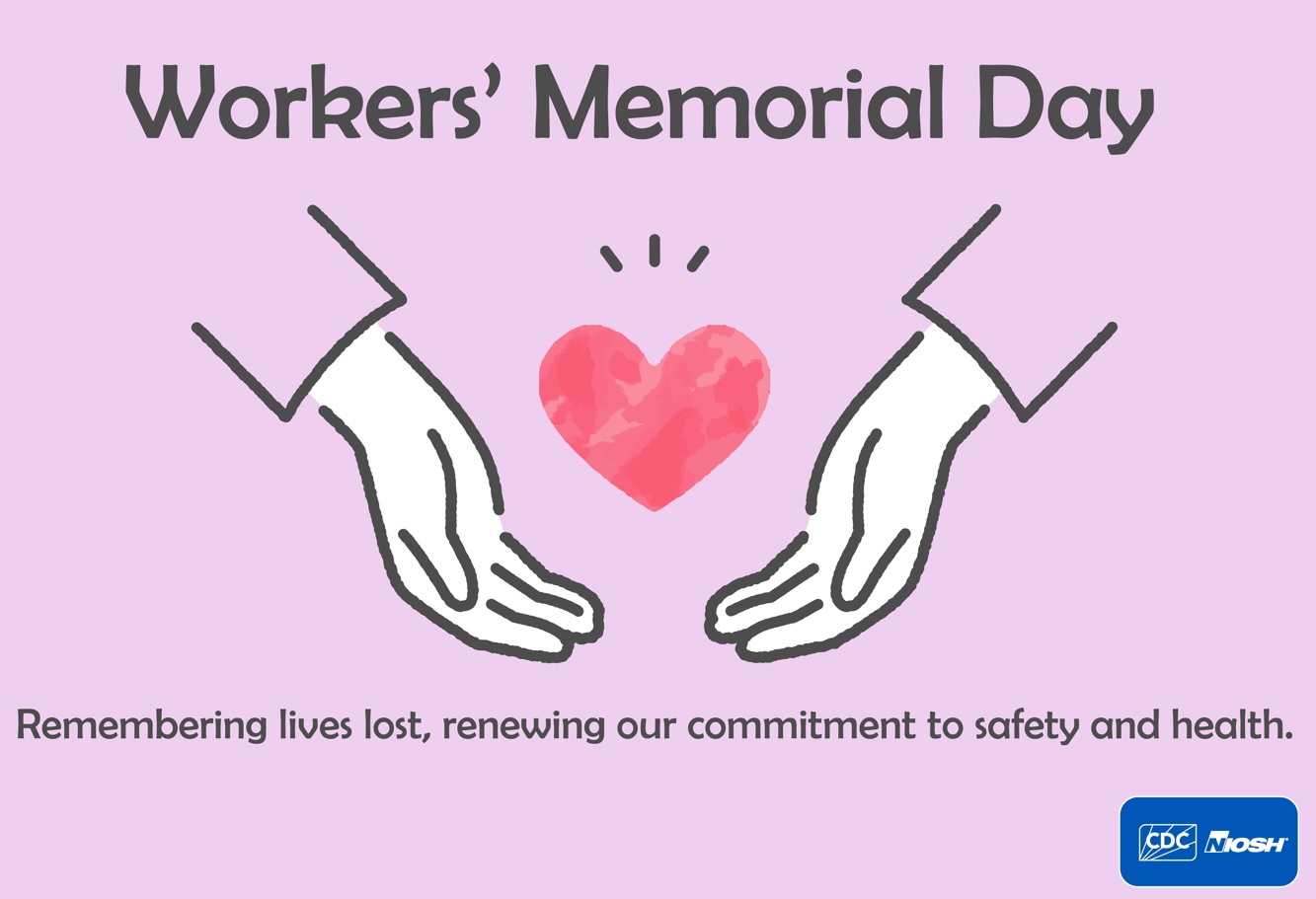Workers’ Memorial Day 2024: Statement by NIOSH Director
Posted on by Each year, on April 28, we pause to recognize Workers’ Memorial Day and honor those whose death or suffering resulted from exposure to hazards at work. Words are not enough when it comes to change. Research has shown that the health and safety of workers relies on active and intentional involvement in ways that take into consideration workplace hazards, work arrangements and environment, employer-worker relationships, the workers themselves, and their families.
Each year, on April 28, we pause to recognize Workers’ Memorial Day and honor those whose death or suffering resulted from exposure to hazards at work. Words are not enough when it comes to change. Research has shown that the health and safety of workers relies on active and intentional involvement in ways that take into consideration workplace hazards, work arrangements and environment, employer-worker relationships, the workers themselves, and their families.
Perhaps one of the hardest things to capture is whether a worker is struggling with poor mental health, which can often be invisible. According to CDC, suicide is among the top leading causes of deaths for people ages 10-64. To address this serious public health issue, the Biden-Harris Administration released the 2024 National Strategy for Suicide Prevention (National Strategy) and the first-ever Federal Action Plan. The National Strategy addresses the ongoing public health crisis and is a direct response to the changing landscape and trends in suicide and suicide prevention. These goals are encompassed within the call to action to “Care. Connect. Collaborate.” to prevent suicide.
Addressing work-related psychosocial hazards – such as violence or bullying, long work hours, shiftwork, lack of control over working conditions – can improve worker well-being. A recent NIOSH report provides societal actions to address this critical issue and a recent blog highlights resources for supporting mental health in the workplace.
There are many feasible ways to champion a mentally healthy workforce. One example is the NIOSH Impact Wellbeing™ campaign which actively engages hospital leaders with evidence-based solutions. Launched in October 2023, the campaign helps to reduce healthcare worker burnout, sustain wellbeing, and contribute to building a system where healthcare workers thrive. One thing is certain, burnout doesn’t discriminate—it exists across every hospital department and job title.
Healthcare workers have historically faced challenging working conditions, including high patient loads, staff shortages, harassment, and violence, which drive burnout and other poor mental health outcomes. A 2023 CDC Vital Signs highlights the further impact the pandemic had on the mental health of healthcare workers. To further address these issues, NIOSH and the Dr. Lorna Breen Heroes’ Foundation released the newest addition to this campaign last month: a hospital-tested guide that provides a step-by-step process for hospitals to start making organizational-level changes that will impact and improve the mental health of their employees. A wealth of resources provided by NIOSH’s Total Worker Health® Program and its partners also brings together all aspects of work in integrated interventions that collectively address worker safety, health, and well-being.
As we know, workplace violence can also contribute to poor mental health. NIOSH has been studying workplace violence since the 1980s. The impact of workplace violence can range from psychological issues to physical injury, or death. Violence can occur in any workplace and among any type of worker, but the risk for fatal violence is greater for workers in sales, protective services, and transportation. In fact, recent NIOSH research shows workplace homicides occurring during a criminal act and those that involved a shooting have increased. The risk for non-fatal violence resulting in days away from work is greatest for healthcare and social assistance workers. Non-fatal workplace violence events among workers have also increased, up 25% between 2015 and 2019 according to recent research. NIOSH and its partners are working to address issues related to violence in the workplace; for example, the creation of the award-winning online training Workplace Violence Prevention for Nurses.
Poor mental health or an undiagnosed mental health condition can be a contributor to suicide. When it comes to instances of death by suicide or attempted suicide, there are many factors to consider at the individual, relationship, and community levels that can contribute to this type of fatality; suicide is rarely caused by a single factor. Suicide is preventable, help is available, and it is important to acknowledge that employers, supervisors, and managers can play a vital role in suicide prevention within all industries. Suicide rates by industry and occupation can also inform workplace prevention. Differences in risk factors among industries and occupations are important and should be used to prioritize effective workplace suicide prevention efforts and more focused research efforts (see related blogs for suicide prevention for construction workers, veterinarians, first responders, and healthcare workers.)
NIOSH is uniquely concerned with the safety, health, and well-being of all workers and understands the impact a workplace can have on a workers’ health, their families, and their communities. The growing portfolio of research and communication around workers’ mental health and well-being is heartening, and NIOSH is committed to advancing its efforts in these areas.
If you are feeling alone and having thoughts of suicide—whether or not you are in crisis—or know someone who is, don’t remain silent. Talk to someone you can trust through the 988 Suicide & Crisis Lifeline. Call or text 988 or chat the lifeline.
John Howard, MD, NIOSH Director
Posted on by

